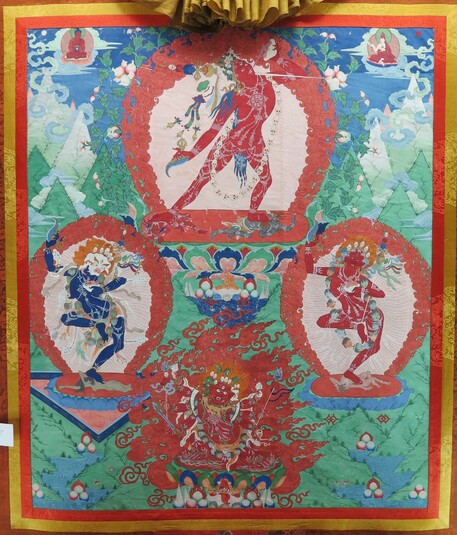
Item: Vajrayogini (Buddhist Deity) - (Naropa Tradition)
| Origin Location | Mongolia |
|---|---|
| Date Range | 1800 - 1899 |
| Lineages | Gelug and Buddhist |
| Material | Ground Mineral Pigment on Cotton |
| Collection | Private |
Classification: Deity
Appearance: Semi-Peaceful
Gender: Female
Vajrayogini, Simhamukha and Vajravarahi. All three of these figures are meditational deities. Vajrayogini and Vajravarahi have as their her special function or activity the goal of reaching complete enlightenment in this lifetime, or soon after. Simhamukha has as her special function or activity the removal of magic, witchcraft, environmental contamination and various types of pollution.
At the top left is a small figure of Amitabha Buddha and on the right side is a monastic figure wearing red robes and a red hat. At the bottom center is 'Secret Accomplishment' Hayagriva.
The subject of the composition are the three principal female meditational deities. Vajrayogini and Vajravarahi are the same deity with two different forms presented in this painting. Those two have a Semi-peaceful and Semi-wrathful Appearance. The Simhamukha with the lion face is in Animal Featured Appearance. The colour red represents power and the overcoming of desire. The colour blue represents wrathfulness and overcomes anger and hatred.
Vajrayogini is red in colour with one face and two hands holding a curved knife in the right and a skullcup upraised in the left. Resting on the left shoulder is a katvanga staff. Adorned with a tiara of skulls and gold, jewel and bone ornaments she wears a necklace of fifty dry skulls standing with the two feet placed on the bodies of red Kalaratri and black Bhairava above a bright orange sun disc and multi-coloured lotus seat. Completely surrounded by the circle of flames of pristine awareness fire she looks up to the pure realm of Khechara and drinks from the skullcup held in the left hand.
Simhamukha has a body dark blue in colour, with one face - that of a white lion, three red round eyes blazing fiercely with a gaping mouth, orange eyebrows and hair flowing upward. The right hand holds aloft a curved knife to the sky, left a skullcup of blood to the heart, carrying a khatvanga staff tipped with a vajra in the bend of the elbow. Adorned with a tiara of five skulls, a flayed human skin and bone ornaments, she wears a tiger skin skirt. Trampling on a corpse with the left foot, above a sun disc and blue lotus blossom, she stands with the right leg drawn up, in a mood of great fierceness dwelling in the middle of a blazing circle of pristine awareness fire.
With a fierce expression, slightly peaceful and slightly wrathful, Vajravarahi is red in colour with one face, three eyes and dark orange hair flowing upward, at the side of the face is a blue boar's head. The right hand holds aloft a curved flaying knife with a gold vajra handle and the left to the heart a white skullcup. In the bend of the left elbow stands an upright tantric katvanga staff, ornate with an green streamer. Adorned with a tiara of five white skulls, blue ribbons and gold and jewel earrings, a garland of fifty fresh heads, a bone necklace, girdle, bracelets and anklets. With the right leg raised in a dancing posture, the left presses on a sun disc atop a prone figure. Above a blue lotus seat, she is completely surrounded by the tight curling flames of orange pristine awareness fire.
"...the King of Wrath, Shri Hayagriva with a body red in colour, three faces, six hands, the main face red, right green, left white. Each face possesses three glaring eyes, bared fangs and a curled tongue, moustache, eyebrows and hair - brownish-yellow, flowing upward. Set atop the faces are three green horse heads with mouths gaping and neighing loudly; from the gaps in the mane sparks issue filling the three thousand-fold world. For the six hands, in the first right a vajra is held, second a katvanga, third a sword. The first left is in a wrathful gesture, second a lance, third a lasso of intestines. Wearing an upper garment of a fresh elephant hide and a human skin, a lower garment of tiger skin, five dry human skulls as a crown and a necklace of fifty fresh, a brahmin cord of human hair, adorned with drops of blood and clumps of charnel ashes. The four right legs are bent and the four left extended - treading on the forms of the eight great nagas; standing in the middle of a blazing fire of pristine awareness." (Tsarchen Losal Gyatso, 1494-1567).
Jeff Watt 12-2-015
Buddha Form | Female Form | Wrathful Form
Buddhist Deity: Vajrayogini, Khechara (Naropa Tradition)
Exhibition: Female Form (DM)
Buddhist Deity: Vajrayogini Main Page
Collection of Dhargye Museum
Collection of Dhargye Museum (Painting Gallery 1)
Buddhist Deity: Vajrayogini (Main Figure)

